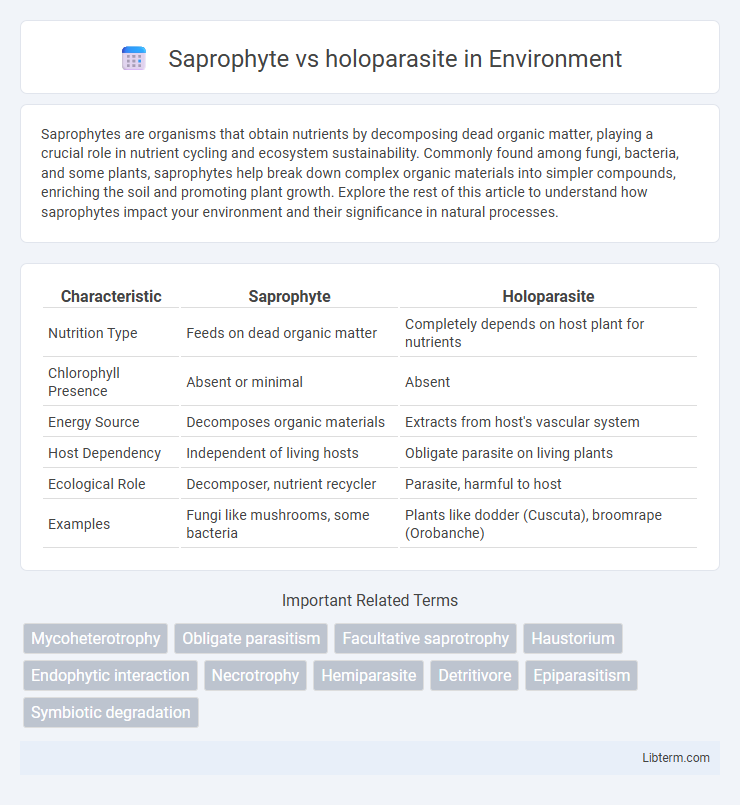Saprophytes are organisms that obtain nutrients by decomposing dead organic matter, playing a crucial role in nutrient cycling and ecosystem sustainability. Commonly found among fungi, bacteria, and some plants, saprophytes help break down complex organic materials into simpler compounds, enriching the soil and promoting plant growth. Explore the rest of this article to understand how saprophytes impact your environment and their significance in natural processes.
Table of Comparison
| Characteristic | Saprophyte | Holoparasite |
|---|---|---|
| Nutrition Type | Feeds on dead organic matter | Completely depends on host plant for nutrients |
| Chlorophyll Presence | Absent or minimal | Absent |
| Energy Source | Decomposes organic materials | Extracts from host's vascular system |
| Host Dependency | Independent of living hosts | Obligate parasite on living plants |
| Ecological Role | Decomposer, nutrient recycler | Parasite, harmful to host |
| Examples | Fungi like mushrooms, some bacteria | Plants like dodder (Cuscuta), broomrape (Orobanche) |
Introduction to Saprophytes and Holoparasites
Saprophytes thrive by decomposing dead organic matter, playing a crucial role in nutrient cycling within ecosystems. Holoparasites completely depend on their host plants for water, nutrients, and organic compounds, lacking chlorophyll and the ability to perform photosynthesis. These contrasting lifestyles highlight diverse survival strategies in the plant kingdom, with saprophytes acting as decomposers and holoparasites as obligate parasites.
Defining Saprophytes
Saprophytes are organisms that obtain nutrients by decomposing dead organic matter, playing a crucial role in nutrient cycling and ecosystem functioning. Unlike holoparasites, which entirely depend on living host plants for sustenance and lack chlorophyll, saprophytes thrive independently without parasitizing living organisms. Key examples of saprophytes include fungi and certain bacteria that break down complex organic compounds into simpler substances.
Explaining Holoparasites
Holoparasites are fully dependent on their host plants for water, nutrients, and organic compounds, lacking chlorophyll and the ability to perform photosynthesis. Unlike saprophytes that derive nutrients from decaying organic matter, holoparasites establish specialized structures called haustoria to penetrate host tissues and extract sustenance directly. Examples include the dodder (Cuscuta) and broomrape (Orobanche) species, which rely entirely on their hosts for survival and reproduction.
Habitat and Environmental Adaptations
Saprophytes thrive in nutrient-rich environments such as decaying organic matter, where they decompose dead plant and animal material using enzymes to absorb nutrients directly from the substrate. Holoparasites inhabit living host plants, often attaching to their roots or stems, completely relying on the host for water, nutrients, and organic compounds due to their lack of chlorophyll. Environmental adaptations of saprophytes include enzyme secretion and tolerance to microbial competition, while holoparasites have evolved haustoria to penetrate host tissues and avoid photosynthesis altogether.
Nutritional Strategies: Saprophytes vs Holoparasites
Saprophytes obtain nutrients by decomposing dead organic matter through extracellular enzymes, relying on external sources of organic carbon and nitrogen. Holoparasites lack chlorophyll and derive all nutrients directly from living host plants by attaching to their vascular tissues, effectively extracting water, minerals, and organic compounds. This fundamental difference highlights saprophytes as decomposers in ecosystems, while holoparasites act as nutrient thieves on living hosts.
Morphological Differences
Saprophytes exhibit distinct morphological traits such as reduced or absent chlorophyll, thread-like roots, and often lack leaves due to their reliance on decomposing organic matter for nutrients, whereas holoparasites show specialized structures like haustoria that penetrate host tissues to extract water and nutrients. Holoparasites typically lack functional leaves and roots, possessing swollen stems adapted for host attachment, contrasting with the more simplistic and filamentous morphology of saprophytes. These morphological differentiations reflect their unique nutritional strategies and ecological niches within plant biology.
Ecological Roles and Importance
Saprophytes play a critical ecological role by decomposing dead organic matter, recycling nutrients, and maintaining soil health, which supports ecosystem sustainability. Holoparasites, in contrast, rely entirely on their host plants for nutrients, often impacting host population dynamics and influencing plant community structure through parasitism. Both saprophytes and holoparasites contribute to ecosystem balance but through fundamentally different biological interactions and nutrient cycles.
Reproductive Methods
Saprophytes reproduce primarily through spore formation, relying on decomposing organic matter for nutrients without parasitizing living hosts. Holoparasites reproduce by producing seeds or spores that germinate on or within living host plants, extracting water and nutrients to complete their life cycle. Both utilize distinct reproductive strategies aligned with their nutritional modes, with saprophytes favoring saprotrophic substrates and holoparasites depending on host attachment for development.
Notable Examples of Saprophytes and Holoparasites
Notable examples of saprophytes include fungi such as mushrooms and molds, which obtain nutrients by decomposing organic matter. Holoparasites like the dodder (Cuscuta) and the ghost plant (Monotropa uniflora) rely entirely on their host plants for water and nutrients, lacking chlorophyll themselves. These distinct survival strategies illustrate the ecological roles of saprophytes in nutrient recycling and holoparasites in plant parasitism.
Key Differences and Comparative Analysis
Saprophytes obtain nutrients by decomposing dead organic matter through extracellular digestion, lacking chlorophyll and relying on external organic sources, while holoparasites are fully parasitic plants that extract water and nutrients directly from a living host plant's vascular system and also lack chlorophyll. Saprophytes play a crucial ecological role in nutrient cycling by breaking down complex organic compounds, whereas holoparasites impact host plant health by diverting essential resources, often resulting in host weakness or death. In comparative analysis, saprophytes thrive independently on decaying matter without harming living organisms, whereas holoparasites depend entirely on a living host for survival, representing different survival strategies within non-photosynthetic plant lifestyles.
Saprophyte Infographic

 libterm.com
libterm.com